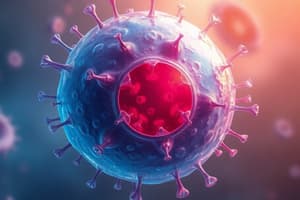Podcast
Questions and Answers
Which condition represents a disordered cellular growth that is considered a precursor to cervical cancer?
Which condition represents a disordered cellular growth that is considered a precursor to cervical cancer?
- Dysplasia (correct)
- Aplasia
- Metaplasia
- Hyperplasia
What is the primary difference between aplasia and hypoplasia?
What is the primary difference between aplasia and hypoplasia?
- Both aplasia and hypoplasia denote increased cell production.
- Aplasia refers to abnormal cell growth, while hypoplasia refers to normal growth.
- Aplasia is the failure of cell production and hypoplasia is a decrease in cell production. (correct)
- Aplasia involves a decrease in size, while hypoplasia involves no cell production.
Which of the following is true about dysplasia?
Which of the following is true about dysplasia?
- Dysplasia is irreversible and always leads to cancer.
- Dysplasia occurs only in connective tissues.
- Dysplasia is characterized by an increase in cell size.
- Dysplasia can result from chronic metaplasia. (correct)
Which condition is characterized by a change in cell type due to stress?
Which condition is characterized by a change in cell type due to stress?
What defines hyperplasia in the context of cellular adaptations?
What defines hyperplasia in the context of cellular adaptations?
What is primarily responsible for hypertrophy in cardiac myocytes in response to systemic hypertension?
What is primarily responsible for hypertrophy in cardiac myocytes in response to systemic hypertension?
Which of the following accurately describes atrophy?
Which of the following accurately describes atrophy?
What is a characteristic of pathologic hyperplasia?
What is a characteristic of pathologic hyperplasia?
What is the main purpose of vitamin A in relation to epithelial cells?
What is the main purpose of vitamin A in relation to epithelial cells?
Which statement correctly describes metaplasia?
Which statement correctly describes metaplasia?
Which type of tissue mostly undergoes hypertrophy without hyperplasia?
Which type of tissue mostly undergoes hypertrophy without hyperplasia?
What triggers hyperplasia in an organ?
What triggers hyperplasia in an organ?
What is a notable characteristic of benign prostatic hyperplasia (BPH)?
What is a notable characteristic of benign prostatic hyperplasia (BPH)?
Flashcards are hidden until you start studying
Study Notes
Hyperplasia and Hypertrophy
- Increased stress causes organs to grow due to increased cell size (hypertrophy) and/or cell number (hyperplasia)
- Hypertrophy involves activating genes, synthesizing proteins, and producing organelles
- Hyperplasia involves producing new cells from stem cells
- Hyperplasia and hypertrophy often occur together, such as in the uterus during pregnancy
- Permanent tissues like cardiac, skeletal, and nerve tissue can only undergo hypertrophy due to their inability to produce new cells
- In response to systemic hypertension, cardiac myocytes undergo hypertrophy rather than hyperplasia
- Pathologic hyperplasia, seen in conditions like endometrial hyperplasia, can progress to dysplasia and eventually cancer
- Benign prostatic hyperplasia (BPH) is an exception to this trend, as it doesn't increase the risk of prostate cancer
Atrophy
- Decreased stress, including reduced hormonal stimulation, disuse, or decreased nutrient/blood supply, causes a decrease in organ size (atrophy)
- This occurs due to a decrease in both cell size and number
- Cell number decreases through apoptosis
- Cell size decreases through ubiquitin-proteosome degradation of the cytoskeleton and autophagy of cellular components
- Ubiquitin-proteosome degradation involves "tagging" intermediate filaments of the cytoskeleton with ubiquitin and destroying them via proteosomes
- Autophagy of cellular components involves the formation of autophagic vacuoles that fuse with lysosomes containing hydrolytic enzymes to breakdown cellular components
Metaplasia
- A change in stress on an organ leads to a change in cell type (metaplasia)
- Mostly involves changes in surface epithelium types (squamous, columnar, or urothelial)
- Metaplastic cells are better adapted to handle the new stress
- Barrett esophagus is a classic example, where the lining of the esophagus changes due to acid reflux
- Metaplasia can sometimes progress to cancer, as seen in Barrett esophagus's potential progression to adenocarcinoma of the esophagus
- Apocrine metaplasia of the breast is an exception as it doesn't increase cancer risk
- Vitamin A deficiency can also cause metaplasia
- Vitamin A is crucial for differentiating specialized epithelial surfaces, like the conjunctiva of the eye
- In vitamin A deficiency, the conjunctiva's thin squamous lining changes to stratified keratinizing squamous epithelium, a condition called keratomalacia
- Connective tissues can also undergo metaplasia
- Myositis ossificans is a prime example where connective tissue within muscles changes to bone after trauma during healing
Dysplasia
- Characterized by disordered cellular growth
- Often refers to the proliferation of precancerous cells, such as in cervical intraepithelial neoplasia (CIN), which precedes cervical cancer
- Often emerges from long-standing pathologic hyperplasia or metaplasia
- Dysplasia can be reversed by alleviating the underlying stress
- If the stress persists, dysplasia progresses to carcinoma, which is irreversible
Aplasia and Hypoplasia
- Aplasia is the failure of cell production during embryonic development, like in unilateral renal agenesis (absence of one kidney)
- Hypoplasia is a decrease in cell production during embryonic development, resulting in a relatively small organ, such as the streak ovary in Turner syndrome
Studying That Suits You
Use AI to generate personalized quizzes and flashcards to suit your learning preferences.




